Atomic Habits Book Summary presents strategies proven to help break bad habits and cultivate good ones through the implementation of tiny routines and behaviors. The book emphasizes that significant results stem from the compounding effect of these small actions. By thoroughly exploring its contents, we aim to provide readers with comprehensive insights, ensuring they grasp the full scope of lessons offered.

Chapter 1
Aggregation Of Marginal Gains
Once upon a time in 2003, British Cycling wasn’t winning much in races and,Then, along came Dave Brailsford, and he had a clever plan called “aggregation of marginal gains.” This meant making lots of small improvements. They started with simple things like comfy bike seats, so the riders wouldn’t feel sore during long races and, they used heated shorts to keep the riders’ muscles just right for cycling. atomic habits quotes. atomic habits review.
But Dave and his team didn’t stop there because they tried out some funny ideas, like special gels to help the cyclists recover faster after races. They even worked with a surgeon to learn the best way to wash hands, reducing the chances of getting sick. And that’s how these little changes added up! atomic habits worksheets. atomic habits review.
In just five years, at the 2008 Olympics, British Cycling won an amazing 60% of the gold medals. And guess what? They also conquered the Tour de France, with Bradley Wiggins in 2012 and Chris Froome later on. atomic habits review.
So, why did they use comfy seats, heated shorts, special gels, and better handwashing? It was all about making the riders feel good, recover quickly, and stay healthy. These tiny changes turned the British Cycling team into champions! atomic habits worksheets.
1% BETTER EVERY DAY. Atomic Habits
Habits are like compound interest for getting better. Even though they may not seem important each day, over time, they make a big difference. It’s like saving a little money – you won’t become rich right away. Or going to the gym a few times – you won’t get fit immediately. Small changes often don’t show quick results, so we go back to our old ways. Atomic Habits pdf. atomic habits worksheets. atomic habits review.
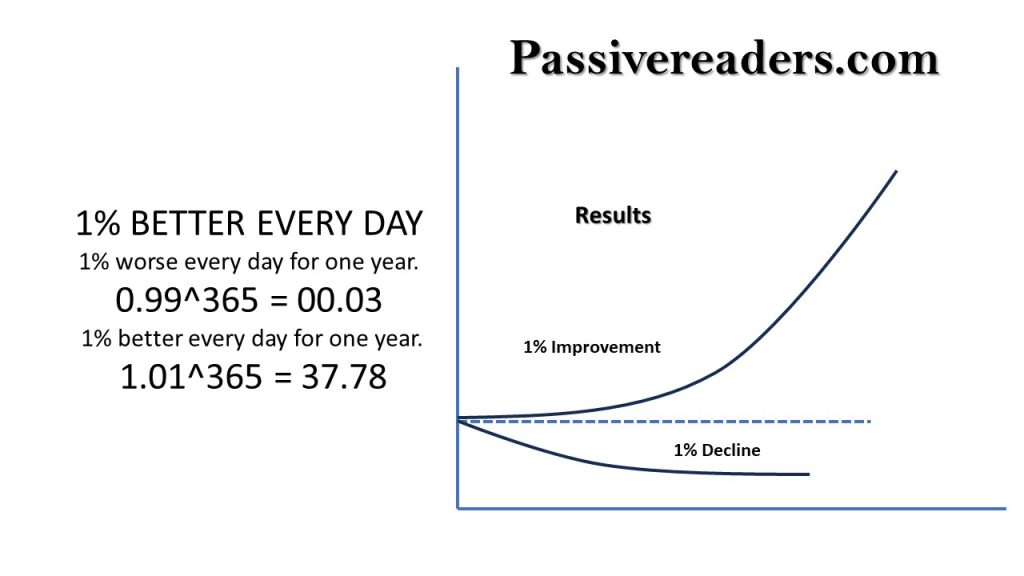
The problem is, bad habits work the same way. Eat unhealthy today, it might not show on the scale right away. If you ignore your family to work late, they’ll probably forgive you. Put off a project until tomorrow, there’s usually time to finish it later. Each single decision might not seem like a big deal. atomic habits pdf
But if we keep making small mistakes every day, like a 1 percent error, they add up. It’s like changing the direction of an airplane by just a few degrees – it doesn’t seem like much at first, but over time, you end up in a different place. The impact of changing your habits is similar – small changes can lead to big results. atomic habits quotes. atomic habits worksheets. atomic habits quote.

Chapter 2
How Your Habits Shape Your Identity (and Vice Versa)
Why IS IT so easy to repeat bad habits and so hard to form good ones?
Changing habits can be tough because we often aim at the wrong target. Think of it like the peeling layers of an onion:
•Outcomes (what we get),
•Processes (what we do), and
•Identity (what we believe)
We usually begin with outcome-based habits, focusing on what we want to achieve, such as losing weight. But a more effective approach is identity-based habits, where we concentrate on who we want to become. By reshaping our beliefs and self-image, we can make habits last. Outcomes are about the results we want, processes are about the actions we take, and identity is about the beliefs we hold. By starting with who we want to be, we can build habits that align with our identity and make lasting changes. Atomic Habits Book Summary. atomic habits pdf. atomic habits quotes. atomic habits worksheets. atomic habits review.
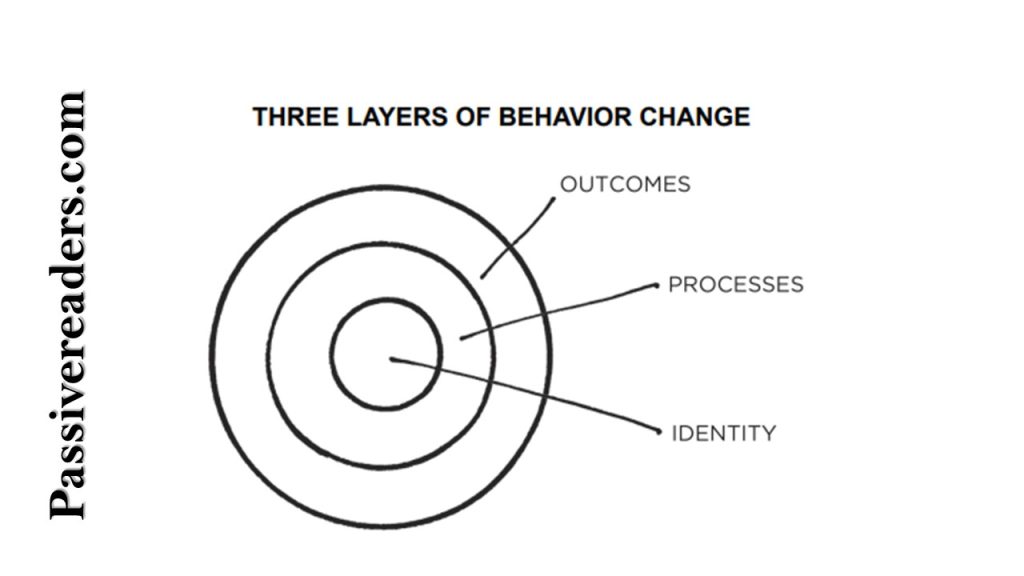
We usually try to change habits to achieve certain results, but it’s better to focus on becoming the person we want to be. By changing our beliefs about ourselves, we can make habits stick. atomic habits quote.

THE TWO-STEP PROCESS TO CHANGING YOUR IDENTITY
- Decide who you want to be: Think about the kind of person you want to become. For example, if you want to be a helpful and caring friend.
- Show it with small actions: Do things that match the person you want to be. For instance, listen to your friends when they talk, help them when they need it, and be kind. These little actions show that you are becoming the person you want to be. Atomic Habits Book Summary. atomic habits pdf. atomic habits review. atomic habits quote.
Chapter 3
How to Build Better Habits in 4 Simple Steps
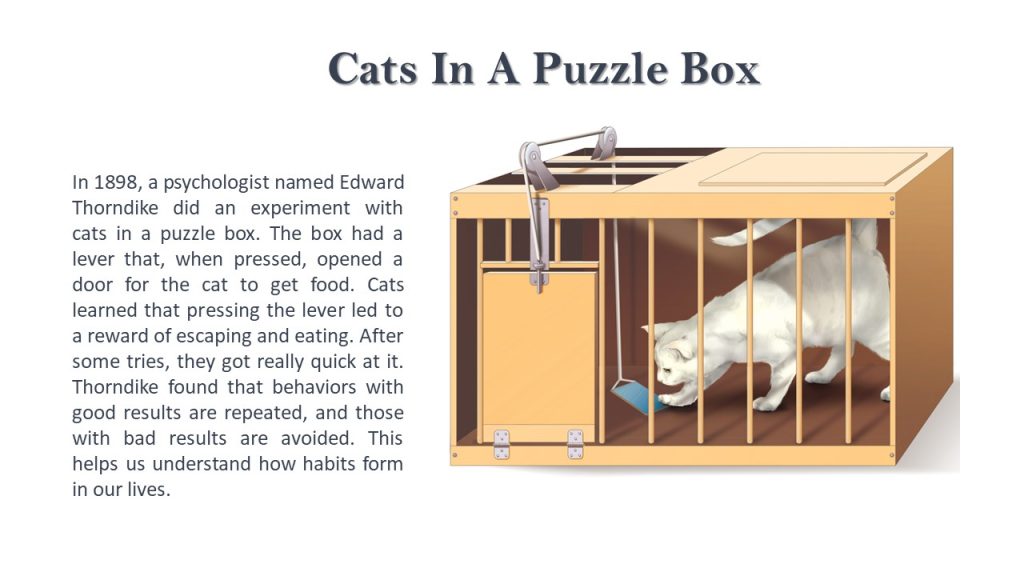
THE SCIENCE OF HOW HABITS WORK
1. Cue: This is a trigger that signals your brain to initiate a behavior. It’s an indication that you’re close to a reward, leading to a craving. (Phone buzzing when a message comes in). atomic habits quotes
2. Craving: The motivational force behind every habit. It’s the desire for a change in your internal state, not the habit itself. ( the desire to know what is in the message). atomic habits worksheets.
3. Response: The actual habit you perform, be it a thought or an action. It depends on your motivation and ability to execute the behavior. ( Grab the phone and read the message). atomic habits quote.
4. Reward: The end goal of every habit. It satisfies your craving, providing benefits and teaching your brain which actions are worthwhile. (you know what is in the message). Atomic Habits Book Summary.
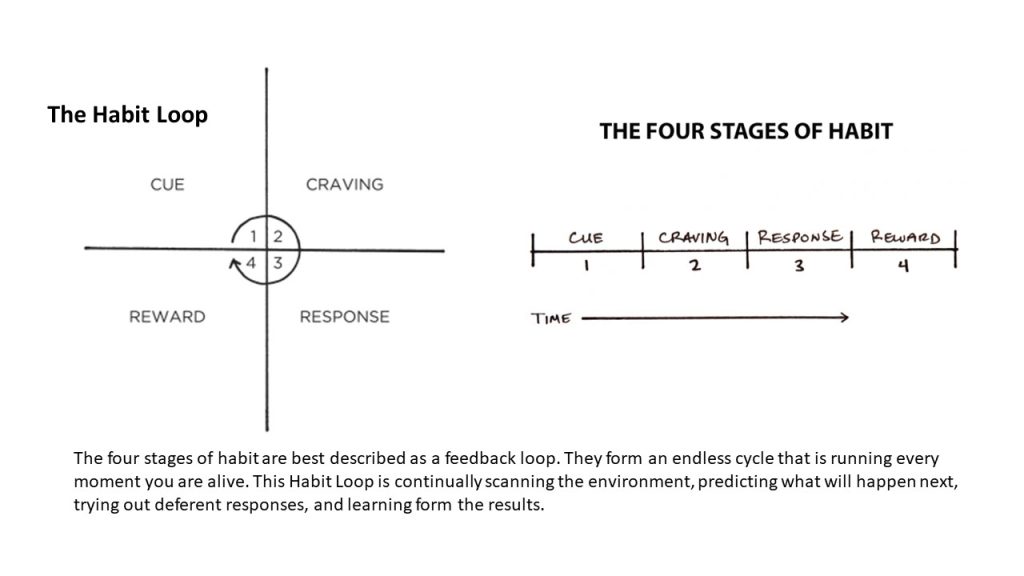
Habits have two phases
Recognizing a Problem ( Cue and Craving)
Finding a solution (Response and Reward).
Every habit aims to solve a problem, whether it’s gaining something good or easing pain.
For example, flipping a light switch in a dark room is a habit that quickly solves the problem of darkness.
THE FOUR LAWS OF BEHAVIOR CHANGE
We’ll explore how daily actions are influenced by cues, cravings, responses, and rewards. Before that, we’ll use the Four Laws of Behavior Change as a simple guide to easily build good habits and break bad ones. Think of each law as a tool for making habits effortless or challenging depending on how it’s used. Atomic Habit Book Summary. atomic habits quotes. atomic habits worksheets. atomic habits quote.
How to Create a Good Habit
The 1st Law (Cue) : Make it Obvious
The 2nd Law (Craving) : Make it attractive
The 3rd Law (Response) : Make it easy
The 4th Law (Reward) : Make it satisfying
How to Break a Bad Habit
1st Law (Cue) : Make it Invisible
2nd Law (Craving) : Make it unattractive
3rd Law (Response) : Make it Difficult
4th Law (Reward) : Make it unsatisfying
Chapter 4
First Law: Make it Obvious
First, we need to be aware of habit before changing it because once it is in our routine, happens without us noticing.
To become more aware of our habits, create a Habits Scorecard with a short and simple list of our daily routines. Write down what we do regularly, like checking our phones, eating snacks, or watching TV. This helps us see our actions clearly and understand our habits better. Atomic Habit Book Summary. atomic habits pdf. atomic habits quotes. atomic habits worksheets. atomic habits quote.
Habit Scoring
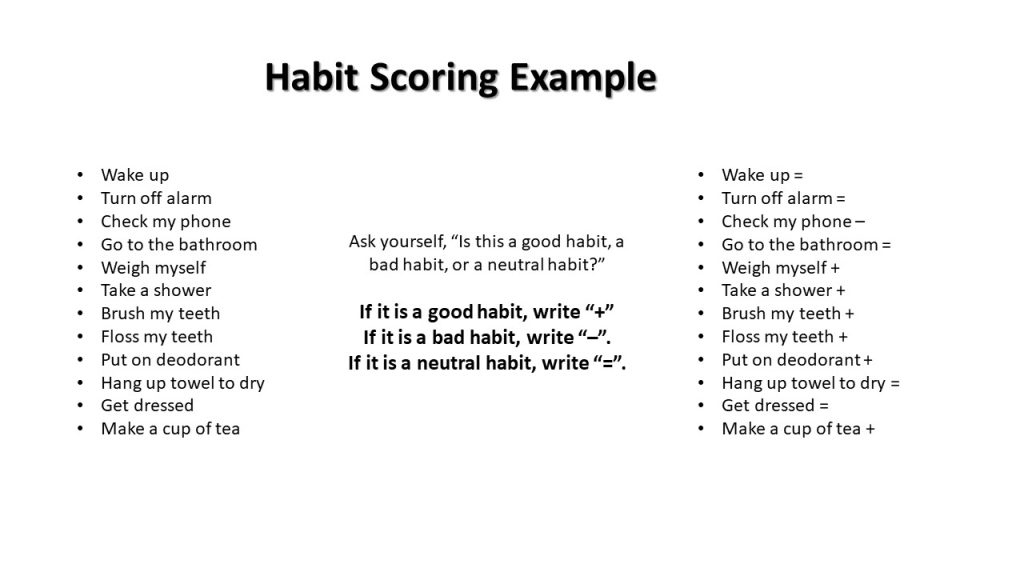
Pointing-and-Calling
In Tokyo’s efficient train system, operators have a unique habit called “Pointing-and-Calling.” They point at things like signals, speedometers, and timetables, stating what they see. It might seem odd, but it’s a safety system that significantly reduces mistakes, cutting accidents by 30%. Even New York’s subway system adopted a similar method, leading to a 57% drop in errors within two years. atomic habits worksheets. atomic habits quote.

Creating a Habits Scorecard helps you understand your habits better. There are no strictly “good” or “bad” habits, just effective ones that align with your goals. Ask if a habit supports the person you want to be. Don’t judge, just observe your habits. To change, notice your habits without blaming yourself. If needed, use Pointing-and-Calling – say your actions aloud to increase awareness and make better choices. The key is being aware of your habits and cues for positive change. atomic habits pdf. atomic habits quotes. atomic habits quote.
chapter 5
The Best Way to Start a New Habit
In 2001, UK researchers wanted to help people exercise more. Three groups were formed: one tracked workouts, the second read about exercise benefits, and the third made specific plans. The group with plans did the best, with 91% exercising weekly, while the first and second groups had 35-38% exercising at least once per week. Making plans beforehand, called implementation intentions, using time and place, proved helpful for building better exercise habits. atomic habits pdf. atomic habits quotes. atomic habits quote.
The simple way to apply this strategy to your habits is to fill out this sentence:
I will [BEHAVIOR] at [TIME] in [LOCATION].
•Meditation. I will meditate for one minute at 7 a.m. in my kitchen.
•Studying. I will study Spanish for twenty minutes at 6 p.m. in my bedroom.
•Exercise. I will exercise for one hour at 5 p.m. in my local gym.
•Marriage. I will make my partner a cup of tea at 8 a.m. in the kitchen.
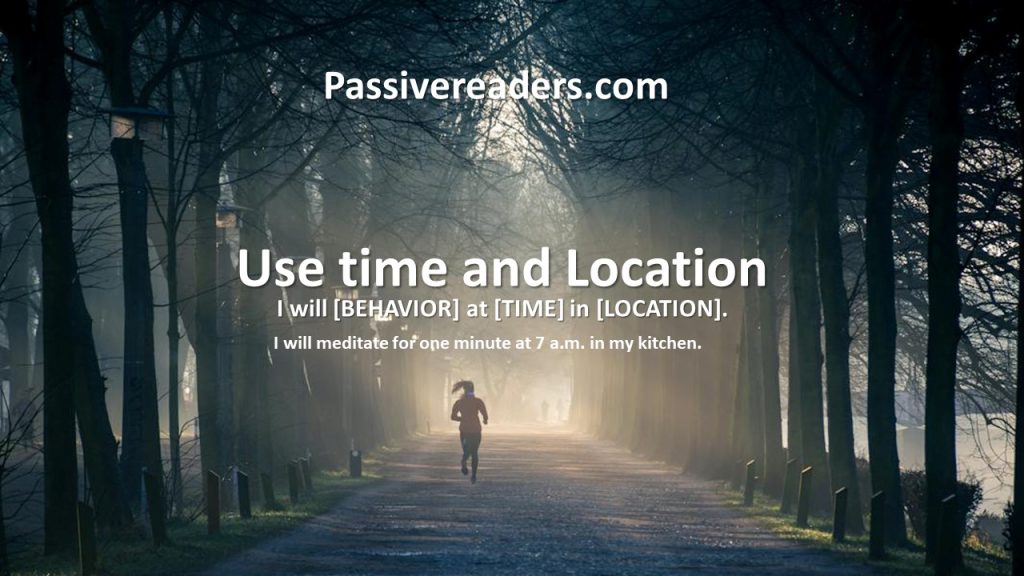
Habit Stacking
One of the best ways to build a new habit is to identify a current habit you already do each day and then stack your new behavior on top. This is called habit stacking. atomic habits pdf. atomic habits worksheets
The habit stacking formula is: “After [CURRENT HABIT], I will [NEW HABIT].
- Meditation. After I pour my cup of coffee each morning, I will meditate for one minute.
- Exercise. After I take off my work shoes, I will immediately change into my workout clothes.
- Gratitude. After I sit down to dinner, I will say one thing I’m grateful for that happened today.
- Marriage. After I get into bed at night, I will give my partner a kiss.
- Safety. After I put on my running shoes, I will text a friend or family member where I am running and how long it will take. Kiss my partner. atomic habits quotes.
You can also insert new behaviors into the middle of your current routines.
Wake up > Make my bed > Take a shower. Let’s say you want to develop the habit of reading more each night. You can expand your habit stack and try something like: Wake up > Make my bed > Place a book on my pillow > Take a shower
Atomic Habits Book Summary
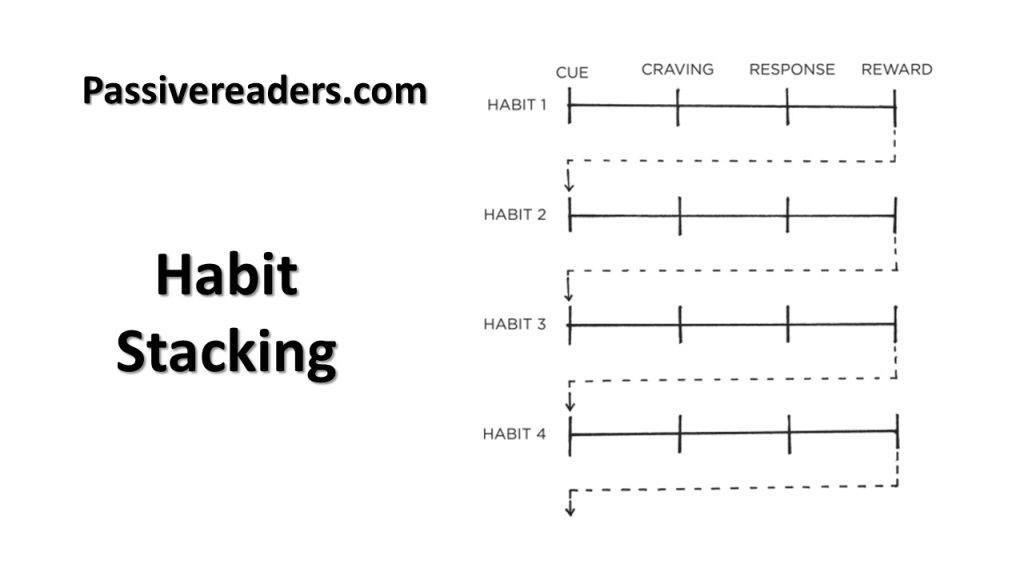
Chapter 6
Motivation Is Overrated; Environment Often Matters More
Dr. Anne Thorndike wanted to improve eating habits without talking to people or changing their motivation. She focused on changing the cafeteria environment at a hospital. They added water next to soda in fridges and placed water baskets around the room. In three months, soda sales dropped by 11.4%, and water sales went up by 25.8%. Similar changes were made with food, all without saying a word to anyone. This shows that changing the environment can impact habits more than motivation. atomic habits pdf. atomic habits quotes. atomic habits worksheets. atomic habits quote.

People often choose products not because of what they are, but because of where they are. If I walk into the kitchen and see a plate of cookies on the counter, I’ll pick up half a dozen and start eating, even if I hadn’t been thinking about them beforehand and didn’t necessarily feel hungr. Atomic Habits Book Summary.
B = f (P,E)
In 1936, psychologist Kurt Lewin wrote a simple equation that makes a powerful statement: Behavior is a function of the Person in their Environment.
HOW TO DESIGN YOUR ENVIRONMENT FOR SUCCESS
In the 1970s energy crisis, Dutch researchers found a suburb where some homes used 30% less energy. The key difference was the location of the electrical meter. Homes with meters in the main hallway used less electricity because it made energy use obvious and easy to track, prompting people to change their behavior. Atomic Habits Book Summary.
In the early 1990s, the cleaning staff at Schiphol Airport in Amsterdam installed a small sticker that looked like a fly near the center of each urinal. Apparently, when men stepped up to the urinals, they aimed for what they thought was a bug. The stickers improved their aim and significantly reduced “spillage” around the urinals. Further analysis determined that the stickers cut bathroom cleaning costs by 8 percent per year. atomic habits pdf.
•Put medication next to the bathroom faucet.
•Place a guitar stand in the living room for more practice.
•Keep thank-you notes on your desk for easy access.
•Put water bottles around the house to drink more water. Making cues obvious helps build good habits, and designing your environment gives you control over your life. Be the architect of your world, not just a consumer.
Chapter 7
The Secret to Self-Control

A better way is to stop bad habits at the source.
Reduce the Exposure, Remove the cues of your bad habits from your environment.
- If your phone distracts you, put it in another room.
- If social media makes you feel bad, unfollow those accounts.
- Move the TV out of your bedroom if it wastes your time.
- Small changes, like hiding cues, can make a big difference.
- Instead of relying on willpower, make good habits obvious and bad habits invisible. That’s the key to self-control – optimizing your environment. atomic habits quote.
The Second Law (Make it attractive)
Chapter 8
The Greylag goose, a ground-nesting bird, has a natural instinct to roll objects like eggs back into its nest. This behavior extends to round objects, even if they are not eggs. Scientists call these exaggerated cues “supernormal stimuli.” Similarly, humans are drawn to exaggerated versions of reality, like highly processed and attractive foods, due to evolutionary instincts.
Supernormal Stimuli
The modern food industry exploits these instincts, creating hyperpalatable foods that trigger overeating. This phenomenon illustrates the 2nd Law of Behavior Change: Make it attractive. Society is filled with supernormal stimuli, making future temptations even more enticing. To increase the likelihood of a behavior, one must make it attractive, tapping into the shared biological signature of habits—the dopamine spike.
Story Time
Ronan Byrne, an electrical engineering student in Dublin, Ireland, loved watching Netflix but knew he needed to exercise more. Using his engineering skills, he hacked his stationary bike, connecting it to his laptop and TV. He wrote a program that allowed Netflix to run only if he cycled at a certain speed. If he slowed down, the show paused until he pedaled again. This creative solution earned him praise for “eliminating obesity one Netflix binge at a time,” combining his love for Netflix with the need to exercise.
Story Time
ABC, the American Broadcasting Company, mastered temptation bundling when they launched their Thursday-night lineup for the 2014–2015 season. Airing three shows created by Shonda Rhimes, they branded it as “TGIT on ABC” (Thank God It’s Thursday). Viewers were encouraged to make popcorn, drink red wine, and enjoy the evening. By associating watching ABC shows with activities viewers already enjoyed, like relaxing with wine and popcorn, ABC made their shows more attractive. This strategy created a habit, making Thursday nights synonymous with relaxation and entertainment. Atomic Habits Book Summary. atomic habits pdf. atomic habits worksheets. atomic habits quote.
1.After [CURRENT HABIT], I will [HABIT I NEED].
2.After [HABIT I NEED], I will [HABIT I WANT].
If you want to watch sports, but you need to make sales calls:
1. After I get back from my lunch break, I will call three potential clients (need).
2. After I call three potential clients, I will check ESPN (want).
If you want to check Facebook, but you need to exercise more:
1. After I pull out my phone, I will do ten burpees (need).
2. After I do ten burpees, I will check Facebook (want).
Chapter 9
The Role of Family and Friends in Shaping Your Habits
In 1965, Laszlo Polgar, a Hungarian man who believed in hard work over innate talent, wrote letters to Klara seeking a wife willing to join his experiment. He aimed to prove that deliberate practice could turn any child into a genius. Choosing chess, Laszlo homeschooled his three daughters, Susan, Sofia, and Judit, dedicating their lives to the game. atomic habits pdf. atomic habits quotes
Susan started at four, defeating adults in six months. Sofia became a world champion at fourteen, later a grandmaster. Judit, the youngest, beat her father at five, became a grandmaster at fifteen, and dominated as the top-ranked female player for 27 years. Their unusual childhood, centered around chess, was deemed attractive by the sisters, who loved the game and found their lifestyle entertaining. The story shows how cultural norms influence what we find attractive and the habits we develop.
People like being together. Long ago, being in groups helped us survive. We copy habits from family, friends, and society. Belonging feels good. We imitate those close, many, and powerful.
Imitating the Close: We naturally copy habits from those close to us, like family and friends. To build better habits, join a group where your desired behavior is normal, making it feel doable and appealing.
Imitating the Many: We tend to follow the group, even if we know it’s wrong. Resisting social norms for personal change can be challenging. atomic habits pdf. atomic habits quotes.
Imitating the Powerful: We’re drawn to actions that bring respect and status. High-status people influence us, making us strive for actions that boost our own status. atomic habits pdf
Chapter 10
How to Find and Fix the Causes of Your Bad Habits
Allen Carr’s Easy Way to Stop Smoking
In late 2012, during a trip to Turkey, I met Mike, an American living there. Over dinner with his Turkish friends, I learned half of them had quit smoking, thanks to a book – Allen Carr’s Easy Way to Stop Smoking. Mike, now smoke-free, praised the book’s strategy. It reframed smoking cues, emphasizing the lack of benefits. By the end, smoking seemed absurd. atomic habits pdf
•You think you are quitting something, but you’re not quitting anything because cigarettes do nothing for you.
•You think smoking is something you need to do to be social, but it’s not. You can be social without smoking at all.
•You think smoking is about relieving stress, but it’s not. Smoking does not relieve your nerves, it destroys them.
Reprogramming Hard Habits
Making challenging habits more attractive involves a mindset shift. Instead of saying, “I have to,” say, “I get to,” turning tasks into opportunities. Reframing habits positively can reprogram your mind, making them more appealing. atomic habits worksheets. atomic habits quote.
Mindset Shift Examples:
1.Exercise: View it as skill-building rather than energy-draining. Say, “It’s time to build endurance and get fast” instead of “I need to run.”
2.Finance: Associate saving with freedom. Living below your current means increases future purchasing power.
3.Meditation: Embrace distractions as opportunities to practice returning to your breath.
4.Pregame Jitters: Reframe nervousness as excitement and an adrenaline rush for better concentration.
Make It Easy
Chapter 11
Walk Slowly, but Never Backward
In the quest for better health and fitness, being in motion might involve researching the perfect workout routine, reading about various diets, and planning an ideal gym schedule. While these activities contribute to knowledge, they don’t directly lead to physical improvements. atomic habits pdf. atomic habits worksheets

On the other hand, taking action would involve hitting the gym, engaging in regular workouts, and adopting a healthier diet. Someone who spends weeks in motion, researching and planning extensively without actually working out, may find themselves no closer to their fitness goals. atomic habits pdf. atomic habits quotes
Preparation is necessary to some extent, it becomes counterproductive when it hinders actual practice. In this context, the key is to start with repetitions, emphasizing the importance of consistent actions rather than perfect planning to master a habit or achieve a desired outcome. Atomic Habits Book Summary
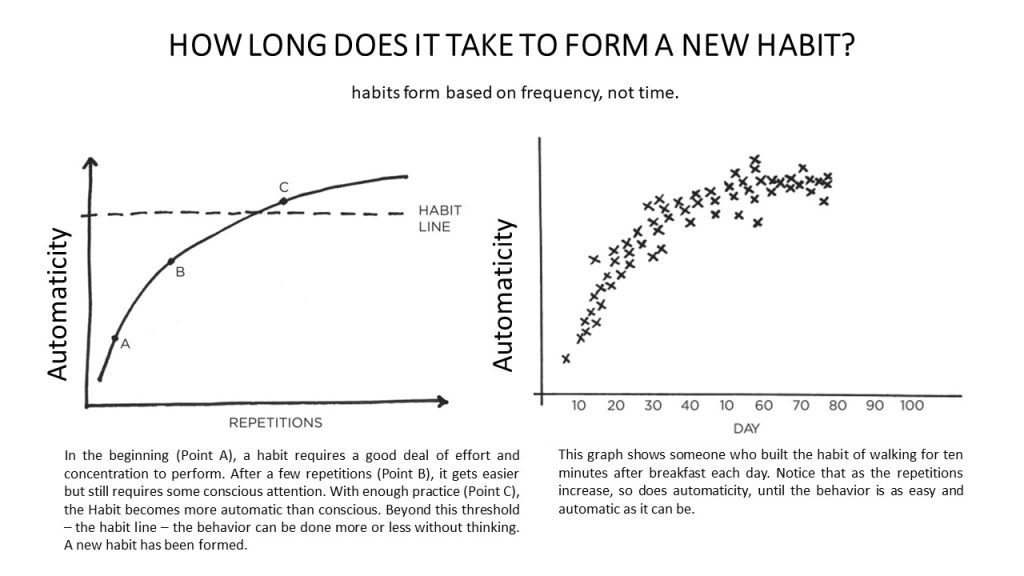
Hebb’s Law
Habit formation involves repetitive actions that lead to physical changes in the brain, known as long-term potentiation or Hebb’s Law. The brain adapts, similar to muscles responding to training, resulting in automatic behaviors through a process called automaticity. atomic habits pdf. atomic habits quotes
For instance, musicians’ cerebellum enlarges, mathematicians’ gray matter increases, and London taxi drivers’ hippocampus grows and shrinks based on their experiences. These examples illustrate how specific regions of the brain adapt and change with repetitive actions, emphasizing the tangible impact of habit formation on neural structures. atomic habits worksheets. atomic habits quote.
Chapter 12
The Law of Least Effort
Our brains like to choose the easiest option. Actions using less energy are more likely to happen. For example, habits like scrolling on phones are easy and take up a lot of time. Habits can be like obstacles, but making them easy helps us stick to them. Even though we can be lazy, keeping things simple in the moment makes it more likely for us to do habits that are good for the long term.
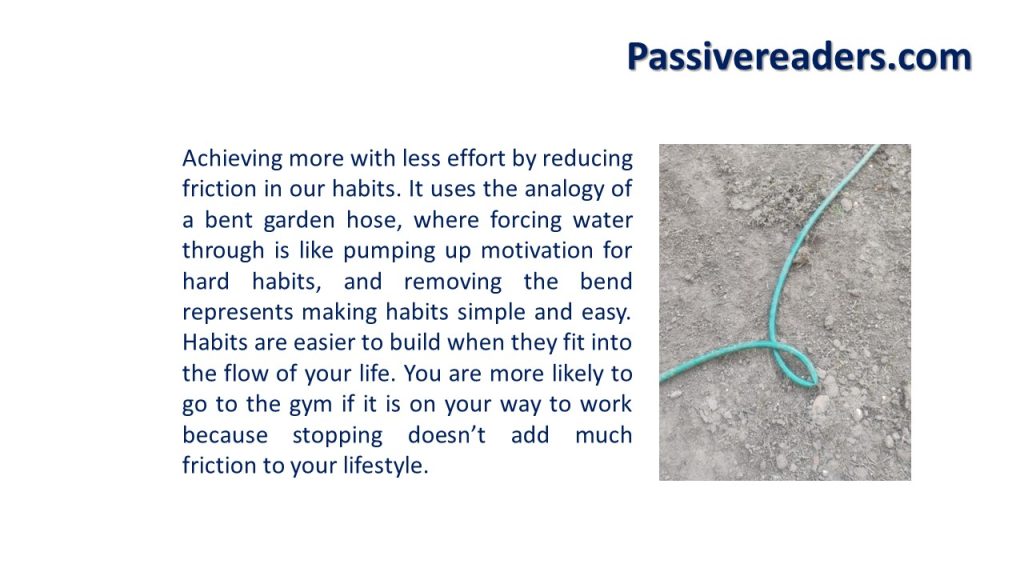
PRIME THE ENVIRONMENT FOR FUTURE USE
Priming your environment means setting it up for success. Oswald Nuckols, an IT developer, practices “resetting the room” to make future actions easier. For instance, he tidies up after each activity, ensuring everything is in its place. This proactive laziness saves time and reduces friction. atomic habits worksheets.
To create an environment conducive to good habits:
1.Cooking: Arrange kitchen items the night before.
2.Drawing: Keep art supplies on your desk for easy access.
3.Exercise: Lay out workout gear in advance.
4.Healthy Diet: Prep fruits and veggies for quick, healthy meals.
Conversely, make bad habits harder:
•TV Watching: Unplug it after each use, or move it to a less accessible place.
•Phone Distractions: Keep it in another room to reduce mindless checking.
Small frictions, like hiding tempting items, can prevent unwanted behaviors. By designing an environment favoring good habits, you make the right actions effortless. atomic habits quote.
CHapter 13
How to Stop Procrastinating by Using the Two-Minute Rule
Decisive moments refer to specific points in time where individuals make choices that significantly impact their actions or behaviors. These moments represent key decision points that can set the course for subsequent events. For example, deciding between ordering takeout or cooking dinner, choosing to drive a car or ride a bike, or opting to start homework instead of grabbing a video game controller are all considered decisive moments. These seemingly small choices can have an outsized impact on one’s daily life and emphasizes their role in shaping behavior. Atomic Habits Book Summary. atomic habits pdf. atomic habits worksheets
Two minute rule
Two-Minute Rule: a new habit should take less than two minutes to do. Nearly any habit can be scaled down to a two-minute version, making it easy to start. The goal is to establish a “gateway habit” that leads to a more productive path. Mastering the art of showing up in the first two minutes sets the foundation for larger routines and deep focus. The rule is not a trick but a strategy to make habits easier, emphasizing the importance of starting small and gradually scaling up. atomic habits worksheets.
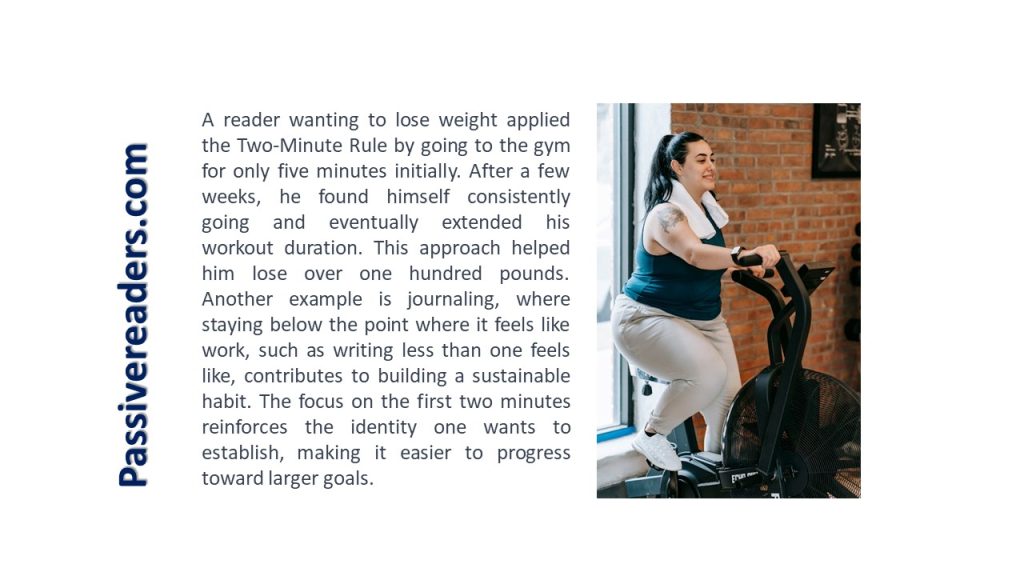
Habit Shaping
Start by mastering the first two minutes of the smallest version of the behavior. Then, advance to an intermediate step and repeat the process—focusing on just the first two minutes and mastering that stage before moving on to the next level. atomic habits quotes. atomic habits worksheets
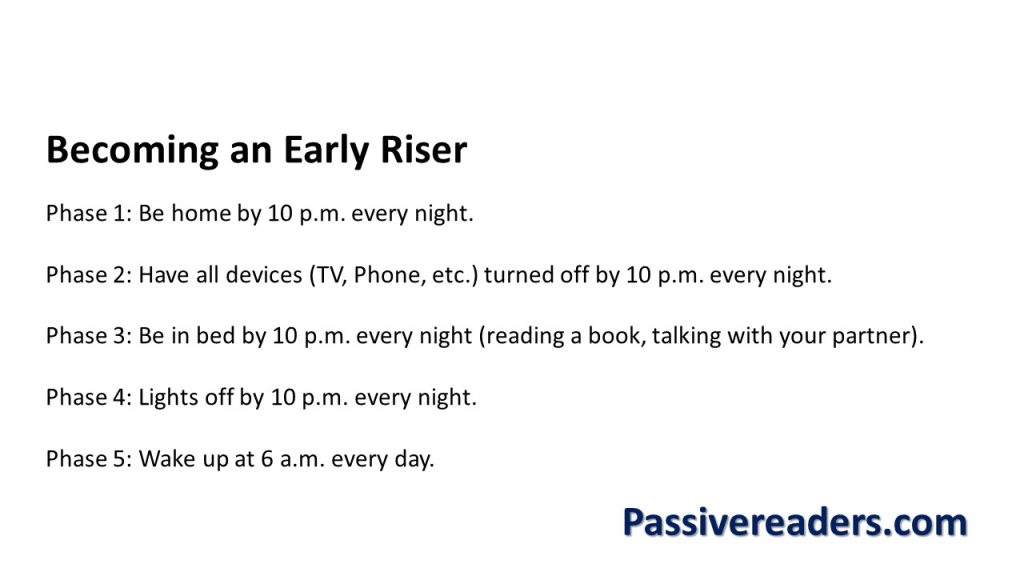

CHapter 14
How to Make Good Habits Inevitable and Bad Habits Impossible
A commitment device is a choice made now to control future actions. It helps lock in good habits and prevents bad ones. atomic habits cheat sheet.
In 1830, Victor Hugo faced a tight deadline for a book promised a year earlier. Procrastinating, he delayed the work. Frustrated, his publisher set a new deadline in less than six months. To overcome procrastination, Hugo took a drastic step. He locked away all his clothes, leaving only a shawl. With nothing to wear outdoors, he stayed in his study and wrote diligently. The result: “The Hunchback of Notre Dame” was published two weeks early on January 14, 1831. Atomic Habits Book Summary. atomic habits quotes. atomic habits worksheets. atomic habits quote.
1.Victor Hugo locked away his clothes to commit to writing.
2.Buying food in small portions prevents overeating.
3.Athletes leave wallets at home to avoid fast food during weigh-in.
4.An outlet timer cuts off internet access at bedtime for better sleep.
5.Paying ahead for a yoga session increases the chance of sticking to a fitness goal.
6.Emailing an entrepreneur and scheduling a call commits to starting a business, making it harder to bail.
HOW TO AUTOMATE A HABIT AND NEVER THINK ABOUT IT AGAIN
John Henry Patterson had a store facing theft issues in the 1800s. Employees were taking money, and it was hard to stop. Then, he discovered the cash register, a new invention that automatically locked cash after each sale. Patterson bought two, and theft stopped overnight. His business turned profitable, and he later started the National Cash Register Company, becoming a big success. The lesson: making bad habits impractical, like the cash register did for theft, is a smart way to break them. atomic habits pdf

Automating habits through technology and strategic decisions allows for more focus on meaningful tasks, freeing up time and energy. However, excessive automation, particularly in leisure activities, can lead to mindless indulgence. The author shares a personal experiment where locking himself out of social media improved his focus and productivity. Automation, when used wisely, can make good habits inevitable and prevent bad ones. Atomic Habits Book Summary. atomic habits cheat sheet. atomic habits worksheets
Make It Satisfying
Chapter 15

pleasure teaches your brain that a behavior is worth remembering and repeating.
Story time
In 1891, Wrigley transformed chewing gum from bland resins to flavorful delights like Spearmint and Juicy Fruit. They marketed it as a way to refresh your taste and promote a clean mouth. The addition of tasty flavors and the promise of a fresh mouth made chewing gum immensely popular, turning Wrigley into the world’s largest gum company. atomic habits pdf. atomic habits quote.
Story time
Similar to chewing gum, toothpaste’s success soared when manufacturers introduced flavors like spearmint and peppermint, creating a pleasurable brushing experience. While flavors don’t enhance toothpaste effectiveness, they contribute to a “clean mouth” feel, making tooth brushing more enjoyable.
Our brains are wired to prefer things that give us immediate rewards, like getting food or avoiding danger, rather than waiting for benefits in the future. atomic habits cheat sheet. atomic habits worksheets. atomic habits quote.
Time Inconsistency
In today’s world, where many rewards come later, like getting paid or being healthy, this tendency can lead to challenges in making good decisions and forming positive habits. The concept of “time inconsistency” where we often value what’s happening now more than what might happen later. Understanding this can help us make better choices and build habits that benefit us in the long run.
Bad habits provide immediate pleasure (e.g., smoking, overeating, unsafe sex), while the negative consequences are delayed. Good habits, on the other hand, often involve unpleasant actions for future benefits. Our brain prioritizes present rewards, making it challenging to rely on good intentions. To succeed, it’s crucial to understand the Cardinal Rule of Behavior Change: What is immediately rewarded is repeated, and what is immediately punished is avoided. People who can delay gratification tend to have better life outcomes. Training yourself to delay gratification involves aligning habits with human nature by adding a bit of immediate pleasure to good habits and a bit of immediate discomfort to bad ones. atomic habits review
HOW TO TURN INSTANT GRATIFICATION TO YOUR ADVANTAGE
Using immediate rewards to strengthen habits. For instance, if you skip shopping, you could immediately deposit $50 into your savings account. Likewise, if you opt to cook dinner instead of eating out, you could set aside the money saved for a future trip to Europe. These instant rewards make sticking to your habits more satisfying, enhancing their likelihood of lasting. atomic habits cheat sheet. atomic habits review
Chapter 16
How to Stick with Good Habits Every Day. Atomic Habits.
A young stockbroker named Trent Dyrsmid used a simple daily habit to achieve success. He started each morning with two jars on his desk: one full of paper clips and the other empty. After making a sales call, he moved a paper clip from the full jar to the empty one. This visual measure of progress kept him motivated. Within eighteen months, he brought in $5 million to the firm and quickly advanced in his career. This technique, known as the Paper Clip Strategy, demonstrates how visual measures can reinforce behavior and provide immediate satisfaction. atomic habits quote.
Another person used a similar method by shifting a hairpin from one container to another when they wrote a page of their book. Similarly, someone else moved a marble from one bin to the next after each set of push-ups. These visual measures of progress provided clear evidence of their achievements and kept them motivated to continue their habits.
HOW TO KEEP YOUR HABITS ON TRACK. Atomic Habits.
Habit tracking is a powerful tool for maintaining consistency in your habits. It involves recording your daily actions to measure your progress over time. Benjamin Franklin and Jerry Seinfeld are notable examples of individuals who used habit tracking to achieve their goals. atomic habits cheat sheet. atomic habits review.
Making Tracking Easier:
1.Automate Measurement: Utilize existing tools like credit card statements or fitness trackers to collect data effortlessly.
2.Prioritize Important Habits: Focus on consistently tracking one or a few key habits rather than sporadically tracking many.
3.Immediate Recording: Record each measurement immediately
4. after the habit occurs to ensure accuracy and consistency.
Habit Stacking + Habit Tracking Formula: “After [CURRENT HABIT], I will [TRACK MY HABIT].”
Example
1.After I hang up the phone from a sales call, I will move one paper clip over.
2.After I finish each set at the gym, I will record it in my workout journal.
3.After I put my plate in the dishwasher, I will write down what I ate.
HOW TO RECOVER QUICKLY WHEN YOUR HABITS BREAK DOWN
Never Miss Twice
Life’s interruptions are inevitable, but the rule of “never miss twice” emphasizes the importance of promptly rebounding from setbacks to prevent the formation of new habits of inaction. Success stems from resilience and quick recovery from failures, rather than striving for perfection. Consistently showing up, even on challenging days, is crucial for sustaining momentum and reinforcing one’s commitment to habits. atomic habits cheat sheet
You start with $100, then a 50 percent gain will take you to $150. But you only need a 33 percent loss to take you back to $100. In other words, avoiding a 33 percent loss is just as valuable as achieving a 50 percent gain. If you’re trying to establish a workout routine, missing a session due to a busy day or lack of motivation might happen. However, adhering to the principle of “never miss twice” means that even if you skip one workout, you commit to returning to your routine as soon as possible. This approach prevents a single lapse from turning into a pattern of inactivity, ensuring that you maintain progress over time. atomic habits cheat sheet. atomic habits quote.
Knowing When (and When Not) to Track a Habit. Atomic Habits.
A restaurant owner initially tracks daily revenue to assess their chef’s performance. However, they realize that this metric doesn’t capture customer satisfaction accurately. They pivot to tracking metrics like meal completion and tip percentage, gaining deeper insights into customer experience and making more informed decisions to improve food quality and service. atomic habits review.
In life, we often use numbers to see if we’re doing well. But sometimes, just looking at numbers isn’t enough. Goodhart’s Law says when we focus too much on a number, we might lose sight of what’s really important. So, while tracking our habits can be useful, we shouldn’t rely on it alone. It’s important to consider other things, like how we feel or small wins we achieve, to get a better picture of our progress toward our goals. Atomic Habits Book Summary. atomic habits review.
Chapter 17
How an Accountability Partner Can Change Everything
Roger Fisher, a negotiation expert, proposed a unique idea during the nuclear war threat of the 1970s and 1980s: implanting nuclear launch codes next to a volunteer’s heart, forcing the President to personally kill someone before launching nuclear weapons. This idea challenges the notion of immediate satisfaction by making a harmful action immediately unsatisfying. Fisher’s proposal underscores the principle that pain is a potent teacher, suggesting that immediate and severe consequences deter bad behavior.
To discourage bad habits, it’s essential to make their consequences immediate and costly. For example, late fees prompt customers to pay bills on time, while linking grades to attendance ensures student presence in class. However, punishments must match the behavior’s severity and be consistently enforced to drive change effectively. Atomic Habits Book Summary. atomic habits review

THE HABIT CONTRACT
A habit contract is a verbal or written agreement in which you state your commitment to a particular habit and the punishment that will occur if you don’t follow through. Atomic Habits Book Summary. atomic habits cheat sheet. atomic habits review. atomic habits quote.
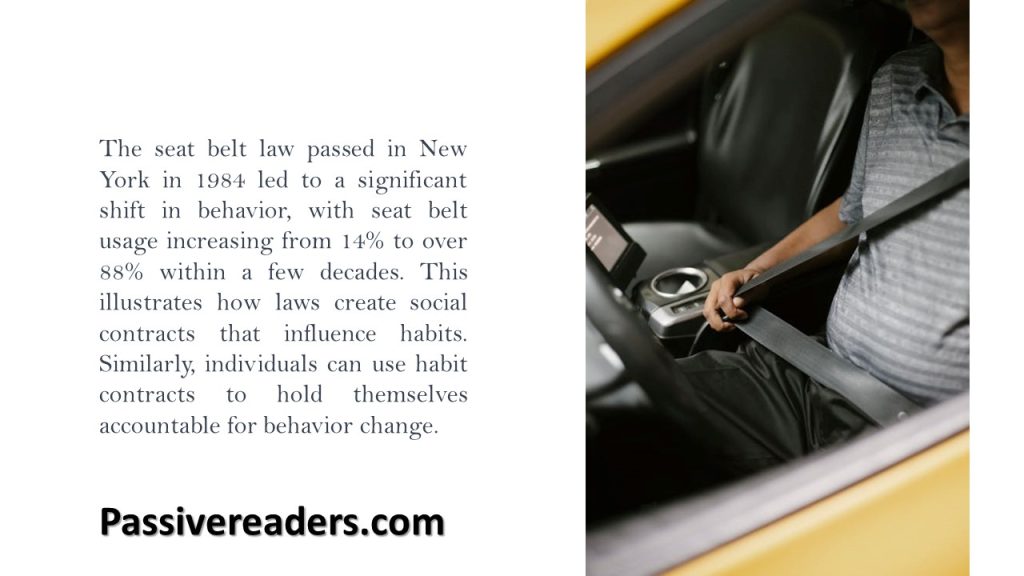
For instance, entrepreneur Bryan Harris crafted a detailed contract with consequences for failing to meet weight loss goals, involving his wife and trainer as accountability partners. Such contracts make bad habits unsatisfying by introducing immediate consequences. Accountability partners or automated reminders can also help reinforce positive habits by adding an immediate cost to procrastination or failure. Ultimately, leveraging social pressure and consequences can be effective strategies for habit change.
How to Go from Being Merely Good to Being Truly Great
Chapter 18
The Truth About Talent (When Genes Matter and When They Don’t). Atomic Habits.
It’s important to pick the right habits and activities based on what we’re naturally good at. It uses the example of athletes Michael Phelps and Hicham El Guerrouj to explain this idea. Even though both were amazing athletes, they excelled in different sports because of their unique abilities. This idea applies to other areas of life too, not just sports. Our genes play a role in what we’re good at, but they don’t decide everything. By choosing activities that match our strengths and interests, we’re more likely to be successful and happy. Understanding our personality helps us figure out what habits and opportunities are best for us. Atomic Habits Book Summary. atomic habits cheat sheet. atomic habits review.
HOW YOUR PERSONALITY INFLUENCES YOUR HABITS
Your personality is the set of characteristics that is consistent from situation to situation.
Our personalities, influenced by genetics, shape our habits. Traits like extroversion, agreeableness, and neuroticism affect our behavior. For instance, extroverts may lean towards socializing, while agreeable individuals may engage in kind acts. Understanding our personality helps us tailor habits to suit our strengths. Finding joy in our habits is crucial for sticking to them long-term. It’s about creating habits that match who we are and leveraging our natural advantages. Atomic Habits Book Summary. atomic habits review
1.Openness: From curious and creative to cautious and predictable.
2.Conscientiousness: From organized and efficient to easygoing and flexible.
3.Extroversion: From outgoing and energetic to reserved and solitary.
4.Agreeableness: From friendly and compassionate to confrontational and distant.
5.Neuroticism: From anxious and sensitive to confident and stable.
HOW TO FIND A GAME WHERE THE ODDS ARE IN YOUR FAVOR. Atomic Habits.
Success is about playing to your strengths. Just like athletes pick sports they’re good at, choose habits that suit you. It’s easier to enjoy things you’re naturally good at. Try different things to see what works best, but also stick with what’s working. Ask yourself questions to figure out what you’re good at. You can create your own opportunities by combining skills and making your own rules. Focus on what you’re best at, even if you’re not naturally great at everything. The key is finding the right game where you have the best chance of winning. Atomic Habits Book Summary. atomic habits cheat sheet
What feels like fun to me, but work to others?
What makes me lose track of time?
Where do I get greater returns than the average person?
What comes naturally to me?
Chapter 19
The Goldilocks Rule: How to Stay Motivated in Life and Work

When starting a new habit, it should be kept easy to stick with, even under imperfect conditions. Once established, it’s vital to make small advancements to stay engaged. Regularly seeking challenges and maintaining novelty is key for motivation and satisfaction in self-improvement. Atomic Habits Book Summary. atomic habits cheat sheet. atomic habits review. atomic habits quote.
HOW TO STAY FOCUSED WHEN YOU GET BORED WORKING ON YOUR GOALS
Success requires enduring boredom and staying committed to habits even when motivation wanes. Variable rewards and a balance between success and failure can keep habits engaging. Consistency and dedication are essential, requiring action even when the mood isn’t right. Embracing boredom is key to achieving excellence in any endeavor. Atomic Habits Book Summary. atomic habits review.
Chapter 20
The Downside of Creating Good Habits
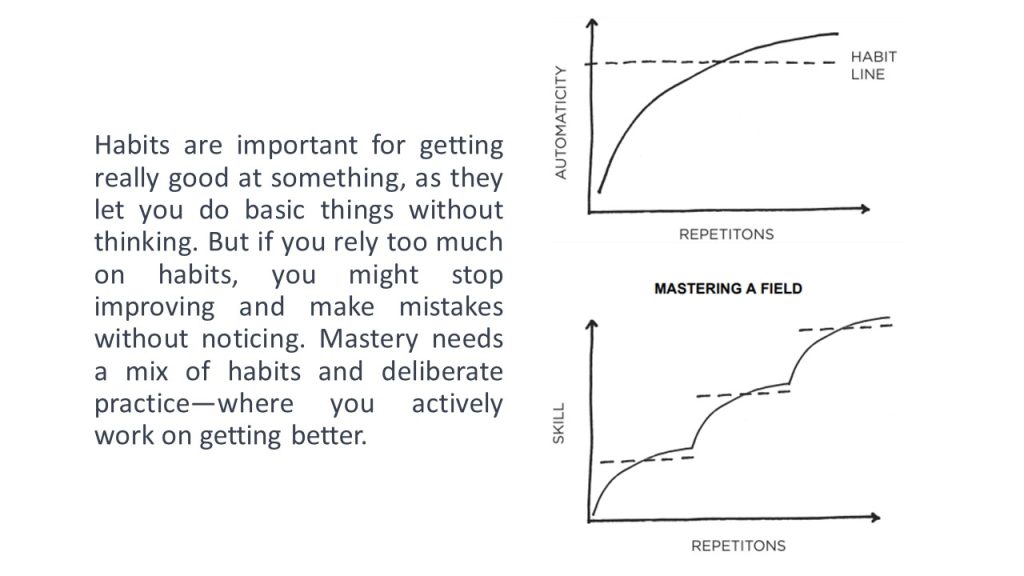
HOW TO REVIEW YOUR HABITS AND MAKE ADJUSTMENTS
The Lakers used a system called CBE to make players better. It compared how well they played to a target number. If a player was really good, they aimed for 800 or more. The coach, Pat Riley, said it’s important to be consistent and see if you’re doing better than before. The Lakers won two NBA championships using CBE. It shows that looking back on how you did helps you get better over time. Atomic Habits Book Summary. atomic habits cheat sheet
Reflect On My Progress. Atomic Habits.
Executives keep a journal to review their decisions and learn from them. Reflection helps us focus on the right things and make changes when needed, like Pat Riley adjusting his players’ efforts. I also reflect yearly and in the summer, asking what went well, what didn’t, and what I learned. This helps me stay on track with my values and goals. It’s like looking at yourself in a mirror from a good distance—seeing the big picture without obsessing over details. Reflection reminds us to align our habits with who we want to be. I conduct two reports: an Annual Review at the end of the year and an Integrity Report in the summer. They help me refine my habits and ensure I’m living in line with my values. atomic habits cheat sheet
HOW TO BREAK THE BELIEFS THAT HOLD YOU BACK. Atomic Habits.
Starting new habits shapes our identity, but clinging too tightly to one identity can hinder growth by making us resistant to change. This happens when we strongly defend beliefs tied to our identity, like a teacher sticking to old methods or a musician unable to innovate beyond their initial success. Keeping our identity small and flexible allows us to adapt to life’s challenges. For instance, shifting from “I’m an athlete” to “I’m someone who embraces challenges.” Reflection and review help break free from old habits and beliefs that may no longer serve us well. Atomic Habits Book Summary. atomic habits review
Conclusion
The Secret to Results That Last. Atomic Habits. atomic habits cheat sheet
The Sorites Paradox teaches us that small actions, when repeated, can have a big impact. Similarly, tiny changes, or atomic habits, may not seem significant at first, but as they accumulate, they transform our lives. Success isn’t about one big improvement, but about countless small ones building up over time. Throughout the book, we’ve learned from top performers who mastered their craft through consistent, small improvements. Success is not a destination but a continuous journey of refining our systems and habits. By following the Four Laws of Behavior Change—making habits obvious, attractive, easy, and satisfying—we can continuously improve. The secret to lasting results is to never stop making small improvements, as they compound over time to bring remarkable results. Atomic Habits Book Summary.
Important worksheets are given below
Read More Book Reviews
7 Habits of Highly Effective People
toto slot toto slot situs toto link slot gacor slot gacor